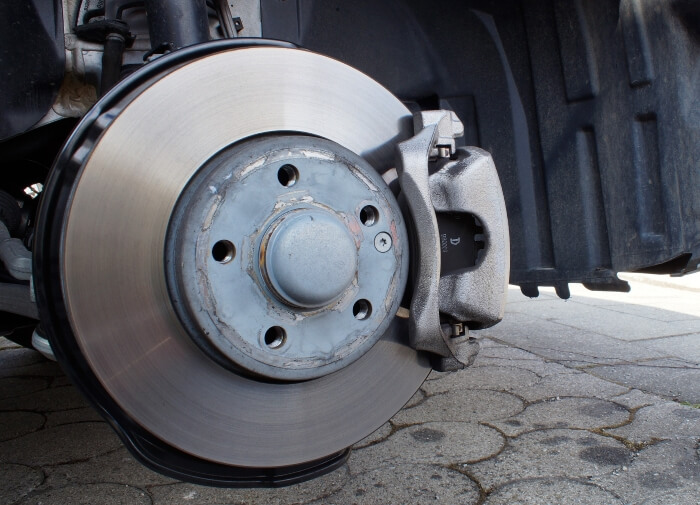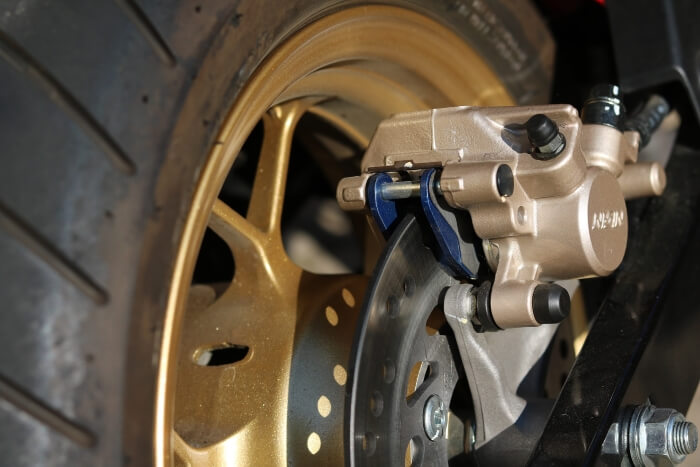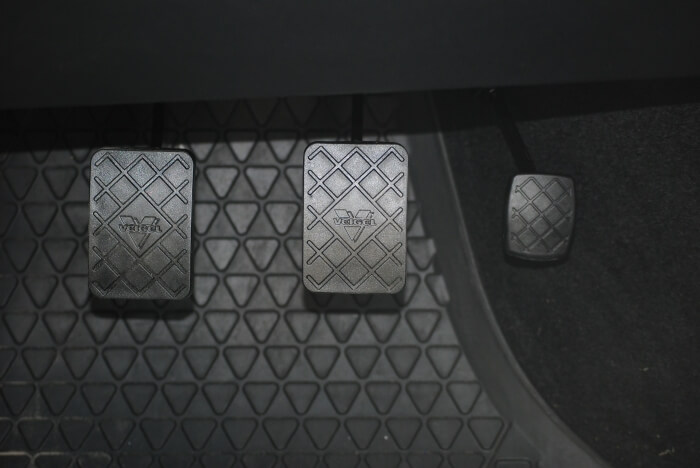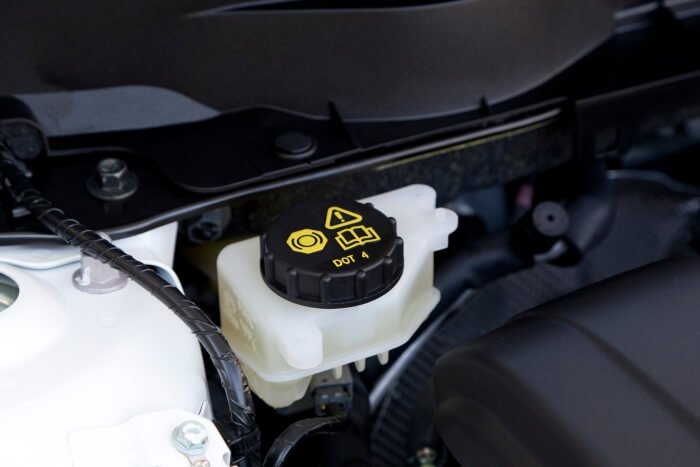


Brake fluid from ADDINOL
Brake fluids are used to transfer the force of the actuated brake pedal to the wheel brake by means of hydraulic pressure. For the liquid to fulfil this purpose, it needs a certain consistency (viscosity) and special properties. This is guaranteed by the use of special raw materials. The brake fluids of ADDINOL are fully synthetic fluids based on glycol ether. Corrosion inhibitors and antioxidant additives are added as additives. The brake fluids are suitable for hydraulic brake and clutch systems with drum and/or disc brakes.
Our brake fluids
ADDINOL BRAKE FLUID DOT 4
Specifications / Approvals:
FMVSS 116 DOT 3, SAE J 1703, SAE J 1704, ISO 4925 Class 4, FMVSS 116 DOT 4
The properties of our brake fluids are:
- High chemical and thermal stability
- Excellent corrosion protection
- High dry and wet boiling point
- No evaporation losses
- Good compatibility with system materials (metals, rubber, plastics)
- Protection against steam bubble formation
Information about brake fluid
Specifications of brake fluids
Brake fluids consist mainly of polyglycol compounds and additives such as corrosion inhibitors. In rare cases, silicone fluids or mineral oils are also used in the manufacture of brake fluids.
The brake fluids are classified according to the American Department of Transportation (DOT). For classification purposes, the minimum requirements of a brake fluid for certain parameters are determined. The parameters include:
- the boiling temperature in °C (boiling point of a fresh, unused brake fluid),
- the wet boiling point in °C (boiling point of the mixture of a brake fluid and 3.5% water),
- the viscosity at 100 °C in mm²/s and
- the cold viscosity at -40 °C in mm²/s.
As a rule of thumb, the higher the DOT class, the higher are the boiling temperature and wet boiling point of the brake fluid. Higher DOT classes sometimes allow longer replacement intervals.
| Parameter | DOT 3 | DOT 4 | DOT 5 |
| Boiling temperature in °C | ≥ 205 | ≥ 230 | ≥ 260 |
| Wet boiling point in °C | ≥ 140 | ≥ 155 | ≥ 180 |
| Viscosity at 100 °C in mm²/s | ≥ 1,5 | ≥ 1,5 | ≥ 1,5 |
| Viscosity at -40 °C in mm²/s | ≤ 1500 | ≤ 1800 | ≤ 900 |
The wet boiling point determines the critical value of the saturation of a brake fluid with water. If 3.5% water has been introduced into the braking system, the boiling point drops sharply. There is a risk of steam bubbles forming. Reaching this value, the brake fluid should be renewed.

Fields of application for brake fluids
In order to select the correct brake fluid, you should follow the manufacturer's instructions for your vehicle. However, the areas of application of brake fluids can be roughly classified by their DOT classes. The DOT 3 brake fluids are used in some older vehicle models such as classic cars. If your car only has DOT 3 approval, do not mix it with DOT 4 brake fluid, as plastic hoses and gaskets may be attacked by the brake fluid.
DOT 4 brake fluids have a higher thermal load capacity than DOT 3 and are usually standard in current European vehicles. There are also brake fluids with lower viscosity for vehicles with electronically controlled brake systems such as ABS and ESP under the designation "DOT4 Plus".
DOT 5 brake fluids are mainly used on the American market. They are based on silicone fluids. Due to the different basic components, they are not compatible with DOT 3 or DOT 4 brake fluids.
The further development DOT 5.1 is based again on polyglycols. DOT 5.1 brake fluid can bind water and has a higher wet boiling point than DOT 3 or DOT 4 standards. This makes it predestined for extreme operating conditions such as those found in racing applications.
By the way, motorcycles use the same brake fluids as cars. There are no special requirements in the braking system of a motorcycle that would justify special designs. Therefore, it only depends on the type of motorcycle and the OEM specifications whether a brake fluid with specification DOT 3, 4, 5, or 5.1 must be filled in.

Mixing brake fluids
In general, brake fluids can be mixed with other brake fluids of the same specification. DOT 3 and DOT 4 brake fluids are easily compatible and can also be used as a mixture if the vehicle manufacturer allows it.
DOT 3 and DOT 4 are not miscible with DOT 5 as DOT 3/4 is based on glycol compounds and DOT 5 is based on silicone. There is a risk of flocculation and blockage of the brake hoses. DOT 5.1 is also produced on a glycol basis and can therefore be combined with DOT 3/4. Of course, changed boiling points of the mixture should be observed.
The ADDINOL BRAKE FLUID DOT 4 is not miscible with brake fluids based on mineral oil!
If you have accidentally mixed two brake fluids that are not compatible or have not been approved by the manufacturer, change the brake fluid as soon as possible.
Frequent problems with brake fluids
Brake fluid is hygroscopic, i.e. it absorbs water from the environment. The binding of the water is on the one hand an advantage, as water can never form drops in the braking system. This could cause rapid corrosion. At the same time, the water droplets would evaporate at 100 °C and form air bubbles in the brake system, which could lead to complete brake loss. In cold conditions, the risk would increase that the brake line would freeze and also no longer fulfil its purpose.
However, it is also a disadvantage if the brake fluid becomes too saturated with water. If a brake fluid is mixed with too much water (over 3.5%), the boiling point of the brake fluid can drop enormously. High temperatures can occur during braking, which in turn cause the fluid to boil if it can no longer withstand this heat. This causes steam bubbles in the brake system. These can interrupt the power transmission from pedal to brake disc and lead to a total failure of the brake system. If your vehicle does not react when you press the brake pedal, drive to the side of the road as soon as possible and let it roll out. Frequent and rapid braking can partially restore the braking effect.
In order to avoid such fatal problems in the best possible way, it is recommended that the brake system be inspected annually as part of an inspection. The filling level of the brake fluid is checked, the fluid is renewed and the integrity of the brake lines and brake hoses is checked. If the brake hoses are leaking, the level of the brake fluid can drop quickly. It can no longer function without sufficient fluid in the brake system. Leaking brake fluid can be identified by greenish shimmering spots under the vehicle. The liquid smells similar to gasoline. If you detect the problem, have your brake system checked in the workshop as soon as possible.

Change brake fluid
In order to check whether the brake fluid used still complies with the manufacturer's specifications, it is best to take your vehicle to a workshop. There the boiling point of the brake fluid can be determined by means of a test device. If the water inlet is too high and the boiling point too low, the brake fluid is replaced. Used brake fluid can also be identified by its colour in the equalising reservoir. It is light brown to brown, whereas fresh brake fluid is clear to light yellow.
Furthermore, certain change intervals must be observed, after which the brake fluid should always be changed. These amount to an average of two years for standard passenger car models.
Always carry out regular checks. If there is too much water in the brake system, there is a risk of corrosion in addition to steam formation. This can cause damage to the brake lines, brake pistons and brake cylinders. Replacing the individual components costs a lot of money.
You can test the condition of the brake fluid yourself at home using brake fluid testers. These determine the water content in the brake fluid. If this is above 3% it is time for a change. The workshop you trust will take care of the problem. Changing the brake fluid or refilling it is only advisable for experts, as a mistake can have fatal consequences. If the level of the brake fluid in the brake fluid reservoir falls below the minimum level, simply refilling the fluid is not sufficient. A defective brake line could be present, which is constantly losing brake fluid and represents a permanent risk. If the level is low, it is better to look for the cause rather than postpone the problem.
Which brake fluid should be filled in can be found either on the cover of the expansion tank or in the service booklet. If you change the brake fluid yourself, be careful not to spill it. Brake fluid attacks paintwork and plastic parts. If anything spills next to the filler necks, rinse it off with plenty of water. Skin contact should also be avoided. Brake fluid irritates skin and eyes. Always wear safety glasses and gloves when handling brake fluid. Since brake fluid is also harmful to the environment, stains on the floor must be absorbed and removed with oil binding agents.
The costs for a change of the brake fluid amount to 40 to 100 € depending on the vehicle type and expenditure in the motor vehicle workshop. If you carry out the change yourself, only the purchase costs for the new brake fluid are incurred. However, you will then also have to take care of the disposal of the old brake fluid yourself.

Dispose of brake fluid
Brake fluids are toxic and corrosive. They are therefore considered hazardous waste and must be disposed of in a special system. They are then reprocessed or further processed in other chemical products. All brake fluids are classified as water hazardous fluids. They must not get into groundwater and must not simply be dumped into drains or canals. Failure to comply with these rules may result in high fines for environmental pollution. The liquids are also not subject to the Waste Oil Act. This means that they must not be mixed with waste oil during disposal. Brake fluids must be disposed of in a separate container.
When changing the brake fluid, collect it in a shatterproof plastic container. The container must be sealable and leak-proof. Take the container to a specialist dealer. They are legally obliged to take back the old brake fluid free of charge. You can also dispense the brake fluid at a nearby recycling centre. Depending on the quantity delivered, costs can arise there. Smaller quantities (1L) for private use are accepted free of charge.

